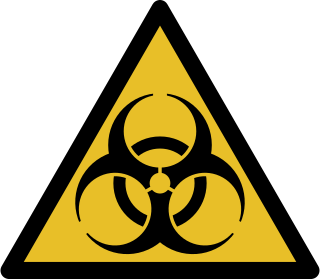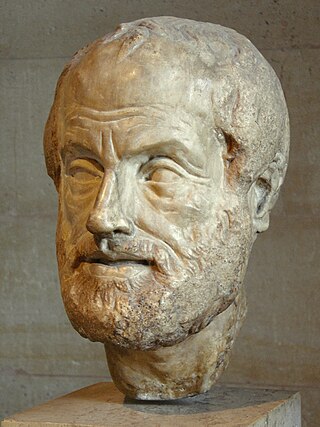
A sign is an object, quality, event, or entity whose presence or occurrence indicates the probable presence or occurrence of something else. A natural sign bears a causal relation to its object—for instance, thunder is a sign of storm, or medical symptoms a sign of disease. A conventional sign signifies by agreement, as a full stop signifies the end of a sentence; similarly the words and expressions of a language, as well as bodily gestures, can be regarded as signs, expressing particular meanings. The physical objects most commonly referred to as signs generally inform or instruct using written text, symbols, pictures or a combination of these.
Semiotics is the systematic study of sign processes and the communication of meaning. In semiotics, a sign is defined as anything that communicates intentional and unintentional meaning or feelings to the sign's interpreter.
Biosemiotics is a field of semiotics and biology that studies the prelinguistic meaning-making, biological interpretation processes, production of signs and codes and communication processes in the biological realm.
In semiotics, a sign is anything that communicates a meaning that is not the sign itself to the interpreter of the sign. The meaning can be intentional, as when a word is uttered with a specific meaning, or unintentional, as when a symptom is taken as a sign of a particular medical condition. Signs can communicate through any of the senses, visual, auditory, tactile, olfactory, or taste.
Zoosemiotics is the semiotic study of the use of signs among animals, more precisely the study of semiosis among animals, i.e. the study of how something comes to function as a sign to some animal. It is the study of animal forms of knowing.

An umwelt is the specific way organisms of a particular species experience the world, which is dependant on what their sensory organs and perceptual systems can detect and interpret.

Thomas Albert Sebeok was a Hungarian-born American polymath, semiotician, and linguist. As one of the founders of the biosemiotics field, he studied non-human and cross-species signaling and communication. He is also known for his work in the development of long-term nuclear waste warning messages, in which he worked with the Human Interference Task Force to create methods for keeping the inhabitants of Earth away from buried nuclear waste that will still be hazardous 10,000 or more years in the future.
The semiosphere is a concept in biosemiotic theory, according to which - contrary to ideas of nature determining sense and experience - the phenomenal world is a creative and logical structure of processes of semiosis where signs operate together to produce sense and experience.
In semiotics, the value of a sign depends on its position and relations in the system of signification and upon the particular codes being used.
In the broadest sense, a code is a correspondence or rule between patterns. It can be an arrangement of physical matter, including the electromagnetic spectrum, that stores the potential to convey meaning. For instance, the pattern of vibration we call 'sound' when activated within the mind, triggers an image; say the word "cat". Also, seeing the shapes we call 'letters' forming the word makes one think of or visualize a cat. The words upon the screen were conceived in the human mind, and then translated into computer code.
In semiotics, denotation is the surface or the literal meaning, the definition most likely to appear in a dictionary.
Encoding, in semiotics, is the process of creating a message for transmission by an addresser to an addressee. The complementary process – interpreting a message received from an addresser – is called decoding.

Representation is the use of signs that stand in for and take the place of something else. It is through representation that people organize the world and reality through the act of naming its elements. Signs are arranged in order to form semantic constructions and express relations.
In semiotics, the study of sign processes (semiosis), the meaning of a sign is its place in a sign relation, in other words, the set of roles that the sign occupies within a given sign relation.

John Deely was an American philosopher and semiotician. He was a professor of philosophy at Saint Vincent College and Seminary in Latrobe, Pennsylvania. Prior to this, he held the Rudman Chair of Graduate Philosophy at the Center for Thomistic Studies, located at the University of St. Thomas (Houston).
In the study of the biological sciences, biocommunication is any specific type of communication within (intraspecific) or between (interspecific) species of plants, animals, fungi, protozoa and microorganisms. Communication means sign-mediated interactions following three levels of rules. Signs in most cases are chemical molecules (semiochemicals), but also tactile, or as in animals also visual and auditive. Biocommunication of animals may include vocalizations, or pheromone production, chemical signals between plants and animals, and chemically mediated communication between plants and within plants.
Social semiotics is a branch of the field of semiotics which investigates human signifying practices in specific social and cultural circumstances, and which tries to explain meaning-making as a social practice. Semiotics, as originally defined by Ferdinand de Saussure, is "the science of the life of signs in society". Social semiotics expands on Saussure's founding insights by exploring the implications of the fact that the "codes" of language and communication are formed by social processes. The crucial implication here is that meanings and semiotic systems are shaped by relations of power, and that as power shifts in society, our languages and other systems of socially accepted meanings can and do change.

Jesper Hoffmeyer was a professor at the University of Copenhagen Institute of Biology, and a leading figure in the emerging field of biosemiotics. He was the president of the International Society for Biosemiotic Studies (ISBS) from 2005 to 2015, co-editor of the journal Biosemiotics and the Springer Book series in Biosemiotics. He authored the books Biosemiotics: An Examination into the Signs of Life and the Life of Signs and Signs of Meaning in the Universe and edited A Legacy for Living Systems: Gregory Bateson as Precursor to Biosemiotics.
The following outline is provided as an overview of and topical guide to semiotics:
Copenhagen–Tartu school of biosemiotics is a loose network of scholars working within the discipline of biosemiotics at the University of Tartu and the University of Copenhagen.





